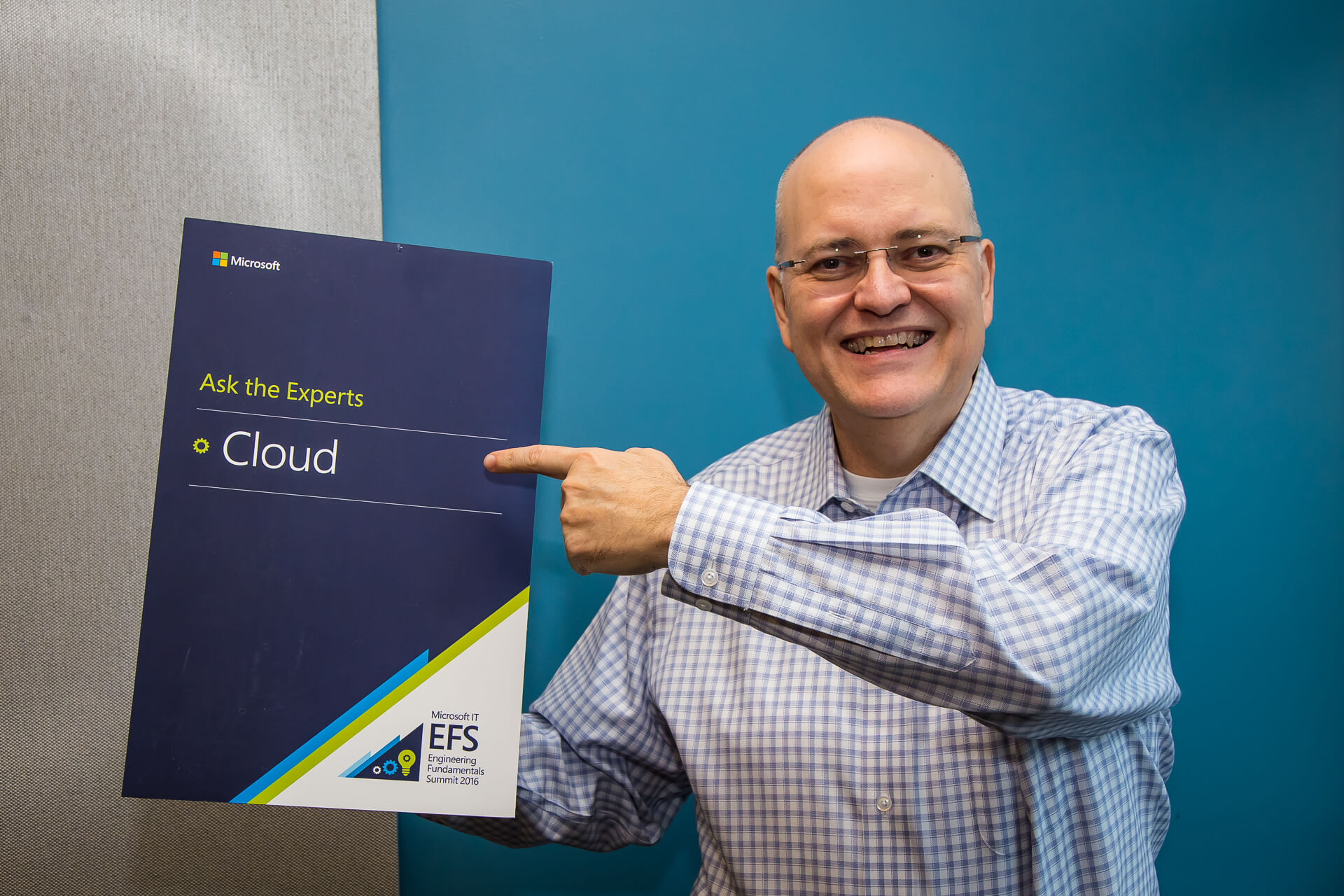This content has been archived, and while it was correct at time of publication, it may no longer be accurate or reflect the current situation at Microsoft.
 Microsoft wasn’t born in the cloud, but soon you won’t be able to tell.
Microsoft wasn’t born in the cloud, but soon you won’t be able to tell.
Now that it has finished “lifting and shifting” its massive internal workload to Microsoft Azure, the company is rethinking everything.
“We’re rearchitecting all of our applications so that they work natively on Azure,” says Pete Apple, principal service engineer on the Microsoft Digital Employee Experience team. “We’re retooling to take advantage of all that the cloud has to offer.”
Microsoft spent the last eight years moving the internal workload of its 60,000 on-premises servers to Azure. Thanks to early efforts to modernize some of that workload while migrating it, and to ruthlessly removing everything that wasn’t being used, the company is now running about 8,500 virtual machines in Microsoft Azure. This number dynamically scales up to around 10,000 virtual machines when the company is processing extra work at the end of months, quarters, and years. It has less than 300 virtual machines on premises, most of which are there intentionally for support of physical labs. The company is now 99 percent in the cloud.
Now that the company’s cloud migration is done and dusted, it’s Apple’s job to craft a framework for transforming Microsoft into a born-in-the-cloud company. Microsoft Digital will then use that framework to retool all the applications and services that the organization uses to provide IT and operations services to the larger company.
The job is bigger than building a guide for how the company will rebuild applications that support Human Resources, Finance, and so on. Apple’s team has created a roadmap for how Microsoft will rearchitect those applications in a consistent, connected way that focuses on the end user experience while also figuring out how to get the more than 3,000 engineers in Microsoft Digital Employee Experience who will rebuild those applications to embrace the modern engineering–fueled cultural shift needed for this transformation to happen.
[Take a deep dive into the learnings, pitfalls, and compromises of Microsoft’s expedition to the cloud. Discover implementing Azure cost optimization for the enterprise. Explore how Microsoft is modernizing enterprise integration services using Azure.]
Move to the cloud creates transformation opportunity
Despite good work by good people, Microsoft Digital’s engineering model wasn’t ready to scale to the demands of Microsoft’s growth and how fast its internal businesses were evolving. Moving to the cloud created the perfect opportunity to fix it.
“In the past, every project we worked on was delivered pretty much in isolation,” Apple says. “We operated very much as a transaction team that worked directly for internal customers like Finance and HR.”
Microsoft Digital engineering was done externally through vendors who were not connected or incentivized to talk to each other. They would take their orders from the business group they were supporting, build what was asked for, get paid, and move on to the next project.
“We would spin up a new vendor team and just get the project done—even if it was a duplication or a slight iteration on top of another project that already had been delivered,” he says. “That’s how we ended up with a couple of invoicing systems, a few financial reporting systems, and so on and so forth.”
Lack of a larger strategy prevented Microsoft Digital from building applications that made sense for Microsoft employees.
This made for a rough user experience.
“Each application had a different look and feel,” Apple says. “Each one had its own underlying structure and data system. Nothing was connected and data was replicated multiple times, all of which would create challenges around privacy, security, data freshness, etc.”
The problem was simple—the team wasn’t working against a strategy that let it push back at the right moments.
“The word that the previous IT organization never really used was ‘no,’” Apple says. “They felt like they had no choice in the matter.”
When moving to the cloud opens the door to transformation
The story is different today. Now Microsoft Digital has its own funding and is choosing which projects to build based on a strategic vision that outlines where it wants to take the company.
“The conversation has completely shifted, not only because we have moved things to the cloud, but because we have taken a single, unified data strategy,” Apple says. “It has altered how we engage with our internal customers in ways that were not possible when everything was on premises and one-off.”
Now Microsoft Digital engineers are working in much smarter ways.
“We now have agility around operating our internal systems that we could never have fathomed achieving on prem,” he says. “Agility from the point of view of elasticity, from the point of view of releases, of understanding how our workloads are being used and deriving insights from these workloads, but also agility from the point of view of reacting and adapting to the changing needs of our internal business partners in an extremely rapid manner because we have un-frictioned access to the data, to the signals, and to the metrics that tell us whether we are meeting the needs of our internal customers.”
And those business groups who unknowingly came and asked for something Microsoft Digital had already built?
“We now have an end-to-end view of all the work we’re doing across the company,” Apple says. “We can correlate, we can match the patterns of issues and problems that our other internal customers have had, we can show them what could happen if they don’t change their approach, and best of all, we can give them tips for improving in ways they never considered.”
Microsoft Digital’s approach may have been flawed in the past, but there were lots of good reasons for that, Apple says. He won’t minimize the work that Microsoft Digital engineers did to get Microsoft to the threshold of digitally transforming and moving to the cloud.
“The skills and all of the things that made us successful as an IT organization before we started on a cloud journey are great,” he says. “They’re what contributed to building the company and operating the company the way we have today.”
But now it’s time for new approaches and new thinking.
“The skills that are required to run our internal systems and services today in the cloud, those are completely different,” he says.
As a result, the way the team operates, the way it interacts, and the way it engages with its internal customers have had to evolve.
“The cultural journey that Microsoft Digital has been on is happening in parallel with our technical transformation,” Apple continues. “The technical transformation and the cultural transformation could not have happened in isolation. They had to happen in concert, and to a large extent, they fueled each other as we arrived at what we can now articulate as our cloud-centric architecture.”
And about that word that people in Microsoft Digital were afraid to say? They’re saying it now.
“The word ‘no’ is now a very powerful word,” Apple says. “When a customer request comes in, the answer is ‘yes, we’ll prioritize it,’ or ‘no, this isn’t the most important thing we can build for the company from a ROI standpoint, but here’s what we can do instead.’”
The change has been empowering to all of Microsoft Digital.
“The quality and the shape of the conversation has changed,” he says. “Now we in Microsoft Digital are uniquely positioned to take a step back and say, ‘for the company, the most important thing for us to prioritize is this, let’s go deliver on it.’”






